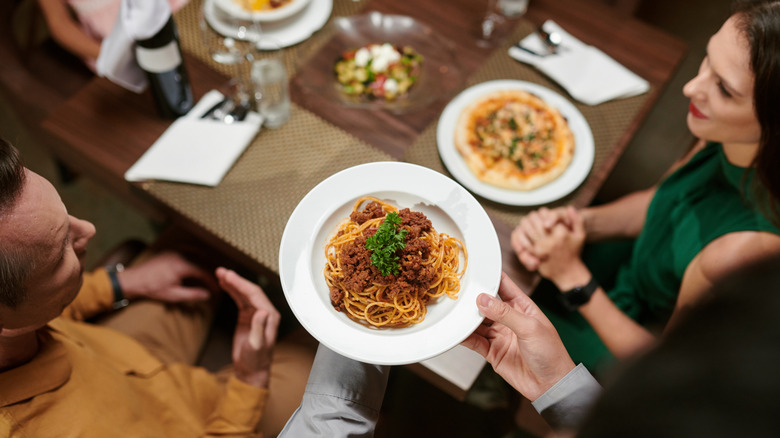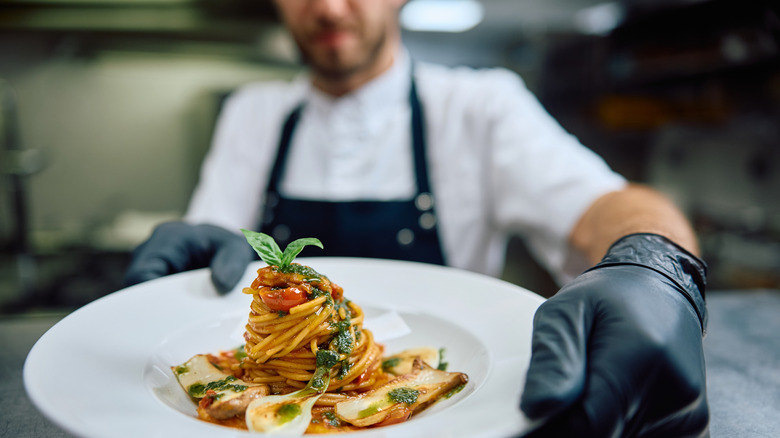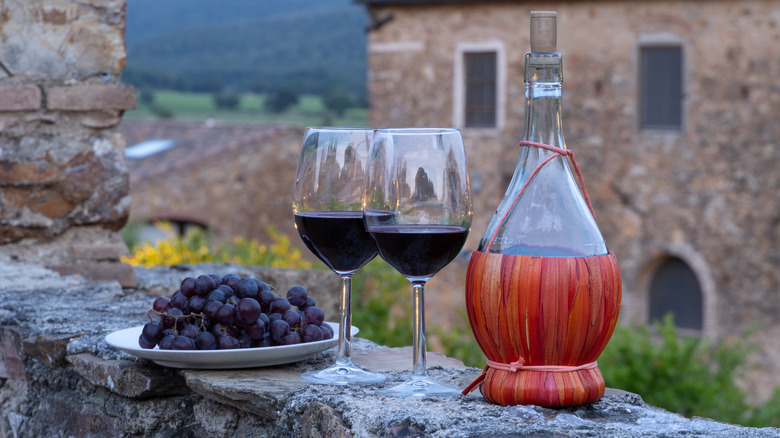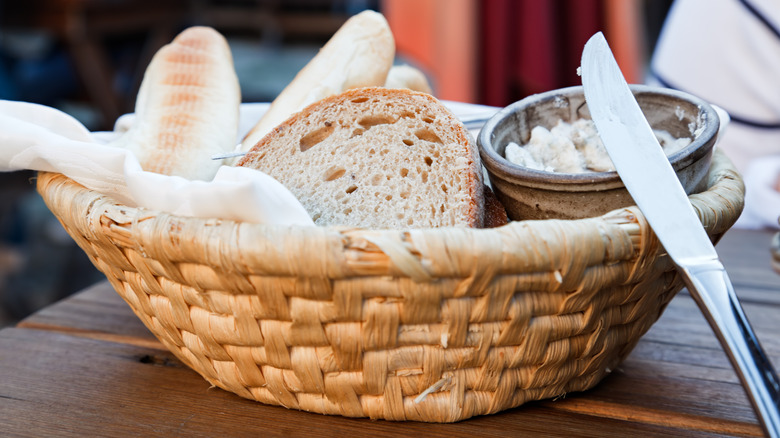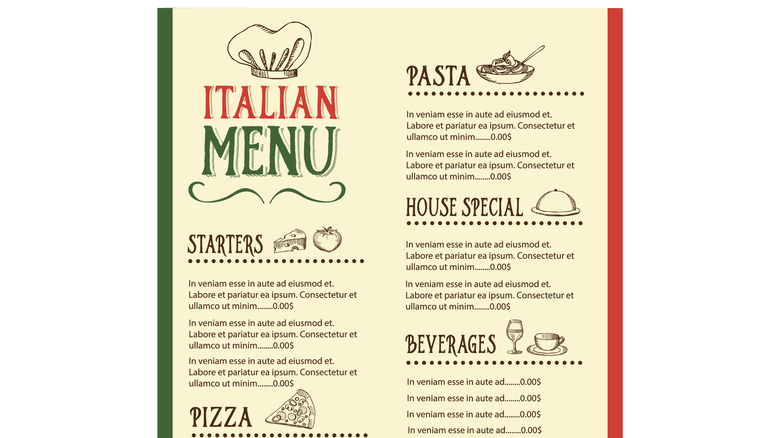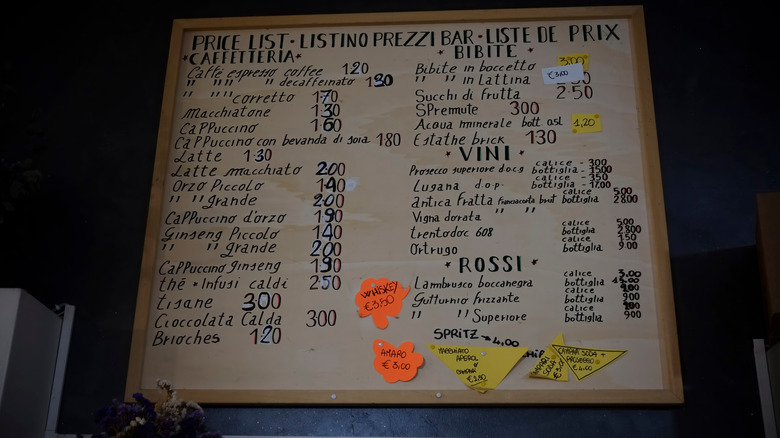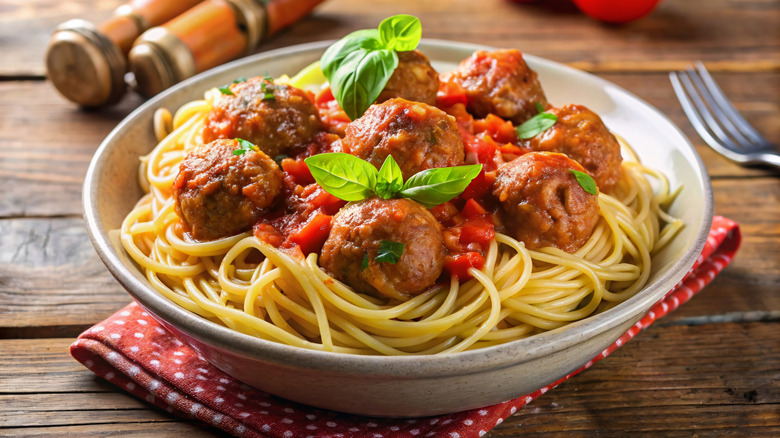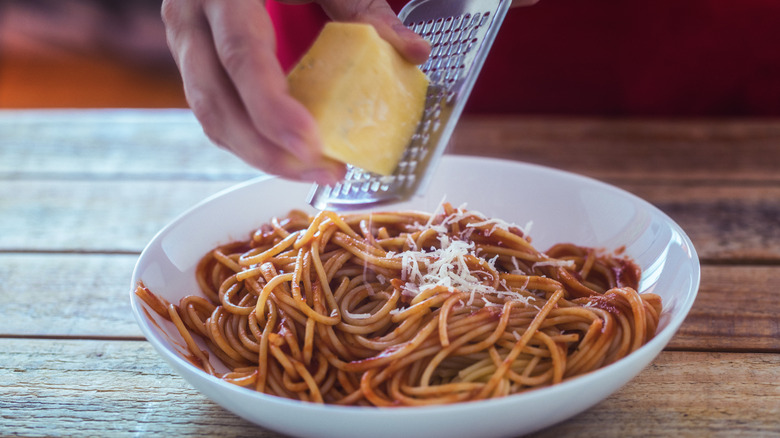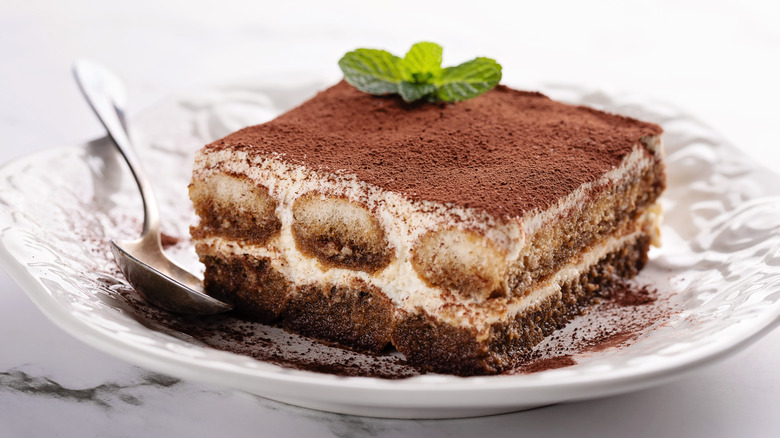Signs You Are At A Bad Italian Restaurant
Dining out is one of life's greatest pleasures. What's better than enjoying a delicious meal that you don't have to cook, is served to you, and, best of all, you don't have to clean up when you're done? The wide variety of cuisines you have to choose from is another thing that makes eating out pretty special. Among the most popular kinds of food is Italian. In the U.S., 35% of diners cite Italian as their favorite cuisine, per Statista.
But you want to be sure the Italian establishment you choose is worth doing business with, just like with any restaurant. But how can you tell if an eatery is worth a try or one you want to avoid? There are telltale signs that a restaurant of this cuisine may not present a good — or even pleasant — Italian dining experience. We have compiled this list to aid you in your quest for good Italian food served at a quality restaurant. Correctly evaluating an Italian restaurant is the first step in finding a new place to enjoy the cuisine.
1. The chef is not Italian or Italian-trained
Preparing delicious, authentic Italian dishes takes much more than just boiling some pasta and opening a jar of sauce. The chef should know that the hallmarks of good Italian food are that it's simple, fresh, colorful, and healthy. The various regions of Italy each have their own cooking styles, and a good executive chef doesn't necessarily have to be from the region to make Italian food, but they should be well-trained in the culinary traditions of that particular cuisine. A good chef knows every detail about the dishes they prepare, such as how many layers you should have in your lasagna.
As the Italian chef and world traveler Cristian Marino says, "Italian food is for me, a lifestyle that gives me taste and well-being." This is the approach you want the chef of an Italian restaurant you are dining at to have. Now, it's not likely that you will be able to interview the head chef at the restaurant. However, thanks to the internet, it's easy to Google the restaurant and its chef to find out their background and training. You can also give the restaurant a call if you prefer. Naturally, checking out online reviews is recommended. It is a good practice and can save you a lot of grief and subpar meals.
2. The drink menu lacks traditional Italian cocktails
Let's face it — food tastes better when you've had a little booze. It is traditional to drink wine with an Italian meal, and we'll get to that, but a cocktail before dinner — perhaps when you're waiting for your table — can enhance the experience. The standard popular cocktails, such as martini, old fashioned, Manhattan, and others, are great drinks, but if you really want the full Italian experience, you may want an Italian drink. Sure, NielsenQ shared data that shows margarita is the most popular cocktail of 2023 in the nation, but save that for Mexican night.
An Italian cocktail will fit in nicely before your meal, and in fact, a newer study conducted by Coffeeness shows that the new favorite cocktail nationwide is the Aperol spritz, an Italian classic. When you look at the restaurant's drink menu, look for classic Italian cocktails such as the Bellini, the limoncello spritz, and the Campari spritz. These should be listed with the aforementioned Aperol spritz and the Negroni. A really good cocktail menu will also feature the limoncello version of the Negroni, which is a refreshing take on the classic recipe. Sure, you're there mainly to eat, but a lack of Italian cocktails could be a sign of a lack of authenticity overall.
3. The wine list is subpar with no Italian wines
When you're having a great meal, pairing it with a fine wine will upgrade the experience. Wine is an essential part of Italian cuisine and culture, so a good Italian restaurant will have an extensive wine list with authentic reds, whites, and sparkling wines.
On the red side, look for pinot noir, cabernet sauvignon, and of course, chianti. These wines pair nicely with pasta dishes and red sauces. The white wine selection should include pinot grigio, Chardonnay, and sauvignon blanc. These are excellent choices to have with clam, shrimp, and chicken dishes. Prosecco is the classic Italian sparkling wine, and any restaurant worth its salt will have it on the wine list.
Naturally, you want quality wines and not something that's $6 purchased at the liquor store down the street. A good restaurant will present you with the bottle. Look at the label. The DOCG (Denominazione di Origine Controllata e Garantita) and DOC (Denominazione di Origine Controllata) logos on the bottle are solid indicators of quality Italian wine. Look for "Classico" on bottles of chianti. This indicates it was made at a traditional hilltop winery. Italian-style wines from California can also be excellent to pair with your meal, as Napa Valley produces some very good products. It's a good idea to ask if the eatery has a sommelier or server with wine knowledge. An Italian restaurant that is neglectful in its wine selection is not one you should patronize.
4. The server brings fresh bread with butter instead of olive oil for you to fill up on
It is common at Italian restaurants in the U.S. for your server to bring over fresh bread and butter or olive oil before you order. Seeing this basket of goodies when you haven't eaten and are hungry may encourage you to fill up. This may seem like a tasty way to start your dining experience, but it is not the Italian way. If you get bread at a restaurant in Italy, it's not the same as a typical eatery in the U.S. In Italy, bread is not an appetizer; rather, it is served to be eaten with other food, but not pasta dishes. Carbs with carbs is a no-no in Italian culture. An exception is bruschetta drizzled with olive oil or focaccia, which are appetizers made with bread.
Another important use of bread in an Italian meal is to sop up the leftover sauce on your plate. This is known as "fare la scarpetta" in Rome and is not only an accepted practice but is encouraged, though take note of other patrons to see if it's alright to do so if it's an extremely fancy restaurant. When you are seated at a new Italian place, pay attention to how the bread is served and what the server tells you about it. It's a good indicator of whether or not you want to return.
5. The menu is overly long and complex, with dishes from multiple regions
Generally, in any kind of restaurant, a menu red flag that should send you running is a long and complex menu. It can easily overwhelm kitchen staff, causing them to take shortcuts and negatively impact the quality of every menu item. Long menus can confuse patrons, lengthening the ordering process and causing inventory issues for management.
When it comes to Italian restaurants, Italy is a fairly large nation with numerous regions that have their own cultures and customs, including cuisine. Northern Italy is known for its rice, so one of the best risottos in Italy is found in Milan. Further south, in the Tuscany region, you will find panzanella salad, tasty steak alla Fiorentina, and perhaps the best pecorino Romano cheese. The Naples area is known for its incredible pizza, eggplant, and other vegetable dishes. As you head further south toward Sicily, seafood, along with veal, is the protein staple.
If a restaurant has all of these kinds of offerings, they are not specializing in one, and it is probably a case of a Jack of all trades, master of none. Find a good restaurant that serves cuisine from one region and does it very well. You can have more than one favorite Italian eatery for different specialties. Just make sure they stick to what they do best and are consistent with the quality, and you will be a happy diner.
6. The names of dishes aren't written in Italian with English descriptions
When you look at a restaurant menu, you naturally want to be able to read it, but odds are, you don't understand Italian. That's okay since Italian names of dishes can add authenticity and let the consumer know that the owner and chef know what they are doing. It is nice to feel like you are actually in Italy, even if you live just down the block from the restaurant.
Of course, it would be more convenient if the menu included English descriptions beneath the Italian text. If you are a little adventurous and like gaining new knowledge, it can be fun to learn to recognize the names of Italian courses and dishes in their original language and even pronounce them properly. Show off a little on a date or a dinner with family and close friends. Whether you learn any Italian or not, be wary of restaurants that do not have the native language anywhere on the menu. Chances are, the food won't be authentic and delicious Italian.
7. The servers are not knowledgeable about the menu and dishes
When you dine in a restaurant, your points of contact and sources of information are the waitstaff. You rely on them more than you may realize. You are not likely to be able to pop into the kitchen and chat up the brigade, but a good server can impart the information you seek. Thus, servers should always be trained to accurately describe the ingredients and cooking methods of every dish on the menu. It also helps if they have sampled them and can make recommendations. This is especially true at a good Italian restaurant.
When servers have no knowledge about what is in the food and how it's prepared, that is a very bad sign. Either they don't care that much about their jobs, or more likely, the management has not taken the time to properly train them and may not care about authenticity or quality. Either way, this is an establishment to pass on.
8. The pasta, tomato sauce, and meatballs are not house-made or are subpar
The quality of the food is essential to Italian eateries. Among the staples that should be outstanding are the pasta, red sauce, and meatballs. These items are among the most popular and are good indicators of the quality of a restaurant.
The best restaurants make their own pasta from simple ingredients like 00 flour, eggs, and olive oil. Handmade pasta has a silkier texture than dry pasta. The flavor and the mouthfeel are delicate. A good, fresh pasta imparts the care and joy of cooking to the diner. It's not just pasta — tomato sauce is also firmly connected to Italian food. You don't want to dine at a restaurant that heats jarred sauce. The best restaurants have a pot of freshly made sauce bubbling daily. The simple, fresh ingredients of Italian cuisine make the best sauces. This does not necessarily mean fresh tomatoes. Even professional chefs use canned tomatoes, so that should not throw you off as long as you enjoy the flavor and consistency.
Meatballs are made by home cooks all the time. In a good eatery, they will taste better than they do at home. That's because restaurants usually source the best quality ingredients, and the chefs know all the tips and tricks for achieving the best results. So, if a restaurant's meatballs are not up to par with what you make at home, it's a clear sign that this is not an establishment you should be dining at.
9. The pizza crust is lackluster
Even if you prefer to enjoy the dish at your local pizza joint, pizza at a good Italian restaurant can be incredibly tasty. Sauces and toppings can vary by region, but the base of any pizza is a delicious crust with the proper texture. There are essential steps to making an authentic Italian pizza crust. It must be made from Italian wheat and be baked at about 900 degrees Fahrenheit in a brick oven, and the dough must be less than 3 millimeters thick before baking.
However, you might not be able to verify the cooking process at the restaurant, and there is more than one way to make a good pizza crust. The best way to tell for yourself is to taste it. It should be crisp on the outside with a nice chewiness inside. Another good way to judge is by the smell emanating from the pizza oven. A great crust gives off a delicious, mouth-watering aroma while baking. If you feel up to asking (remember, good Italian restaurants have knowledgeable servers), find out how the crust is made. It should be simple, healthy ingredients like organic flour and water. A crust that is soggy, overly chewy, or sweet rather than savory is a sign of a bad Italian restaurant.
10. The Parmesan cheese comes pre-grated in a shaker
If you request some Parmesan cheese and your server comes over with one of those glass shakers you find in every neighborhood pizza place, do not return to that restaurant. No self-respecting Italian chef would ever allow such a thing in their restaurant. At a good eatery, your server will bring over a fresh block of delicious Parmesan and a grater. They will ask if you would like some and expertly grate it over your food until you tell them to stop. A top-notch restaurant will use Parmigiano Reggiano, aged for 10 months. It tastes better, has a superior texture, and will enhance the flavor of your meal.
High-quality cheese is one of the hallmarks of Italian cuisine in every region. Mozzarella, asiago, burrata, fontina, pecorino Romano, and good old Parmesan. Italians are as proud of their cheese as they are of their wine and food. Do not take cheese in a shaker lightly. It may even be processed and store-bought — not a sign of a good restaurant at all.
11. The restaurant doesn't have authentic Italian desserts
When you go out for a good meal, you generally want the entire experience, and that includes dessert. That course is essential in Italian cuisine. After all, the best meals at the top restaurants lead you from your pre-meal cocktail all the way through to dessert and more.
Dolce (dessert) is as important as the other courses, so if you look at the dessert menu at an Italian restaurant and see things like red velvet and chocolate cake and lemon meringue pie, that's a big red flag. Not that those are not tasty desserts, but they are not Italian. An authentic restaurant will have tasty tiramisu, cannoli, panna cotta, millafoglie, gelato, or other classic Italian desserts. Look out for crostata, the traditional Italian dessert that came well before tiramisu. Skimping on genuine Italian desserts is not done in good restaurants, so avoid dining at the ones that do.
12. Espresso is not on the menu
What goes better with dessert after a great meal than a nice cup of coffee? There are a lot of kinds of coffee beans and blends, many of which are delicious. An authentic Italian meal ends with espresso. It is a staple in Italy, and Italians believe it aids in the digestion of a heavy meal. The acidity is thought to be the key to this ability. It can help you relax while chatting with your party about how good the meal was.
Espresso is usually enjoyed as a single shot in a small cup called a demitasse. Restaurants will typically serve it with sparkling water. This cleanses the palate to allow enjoyment of the espresso's bold flavor. A nice shot of espresso is warming and helps end your dining experience on a soothing and relaxing note. Even if you are not a coffee drinker, be aware of whether or not the menu has espresso. An omission of the popular beverage is an indication that this restaurant is not all it could be, and there could be other non-authentic aspects to it.
